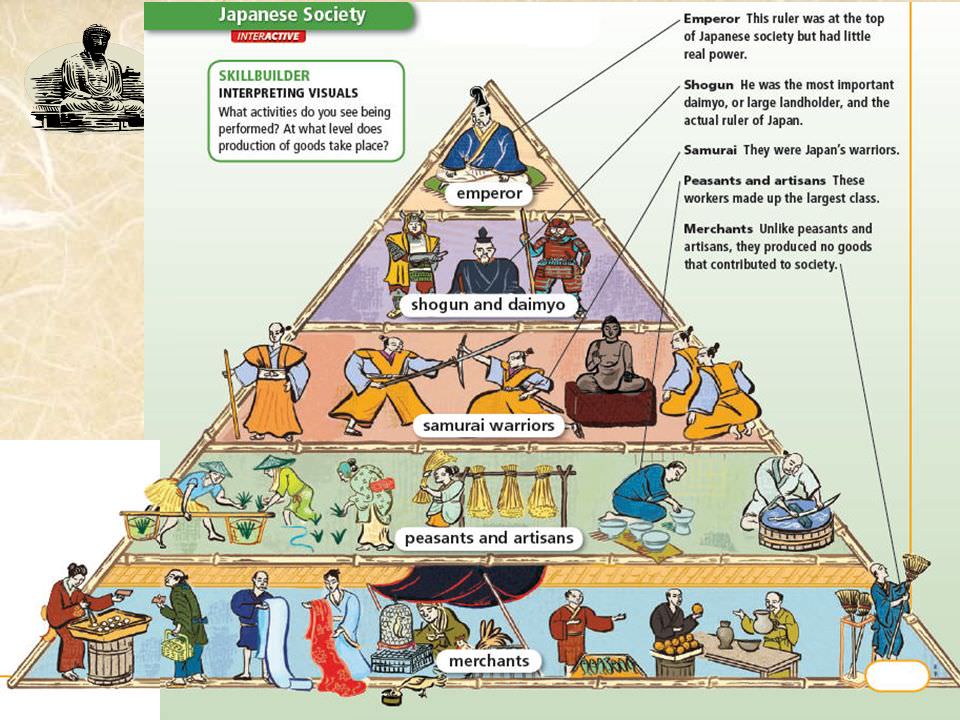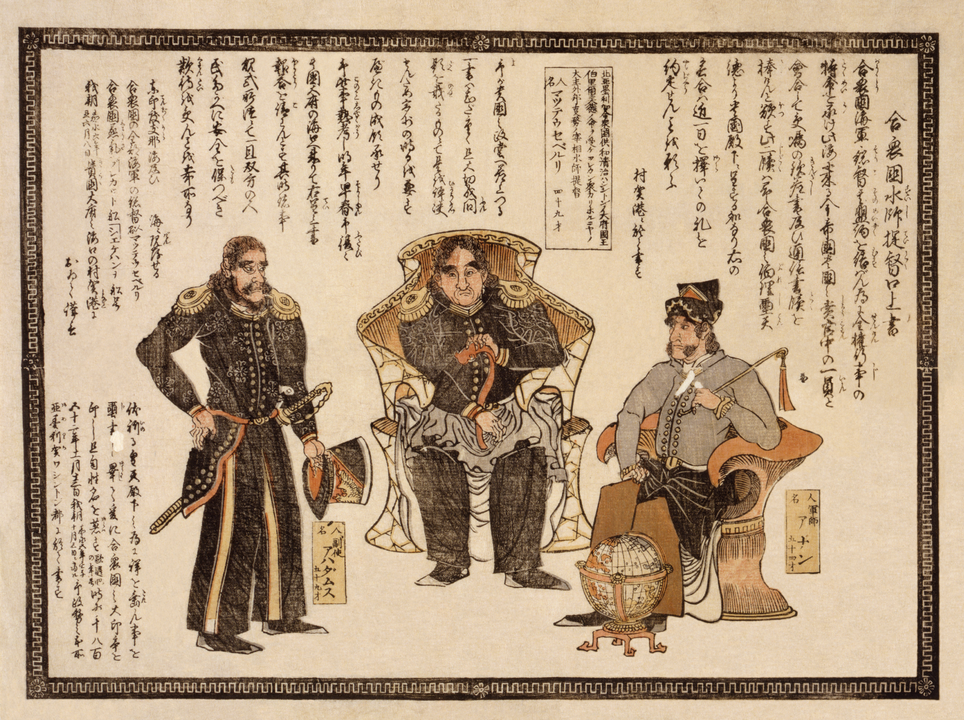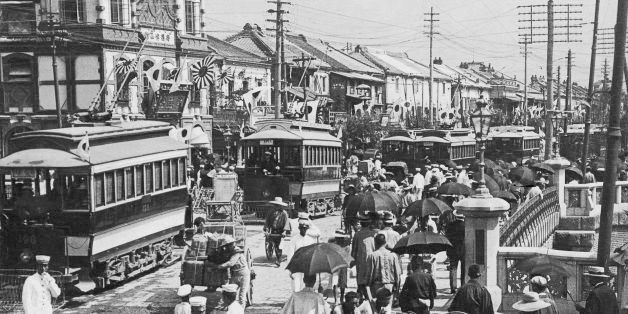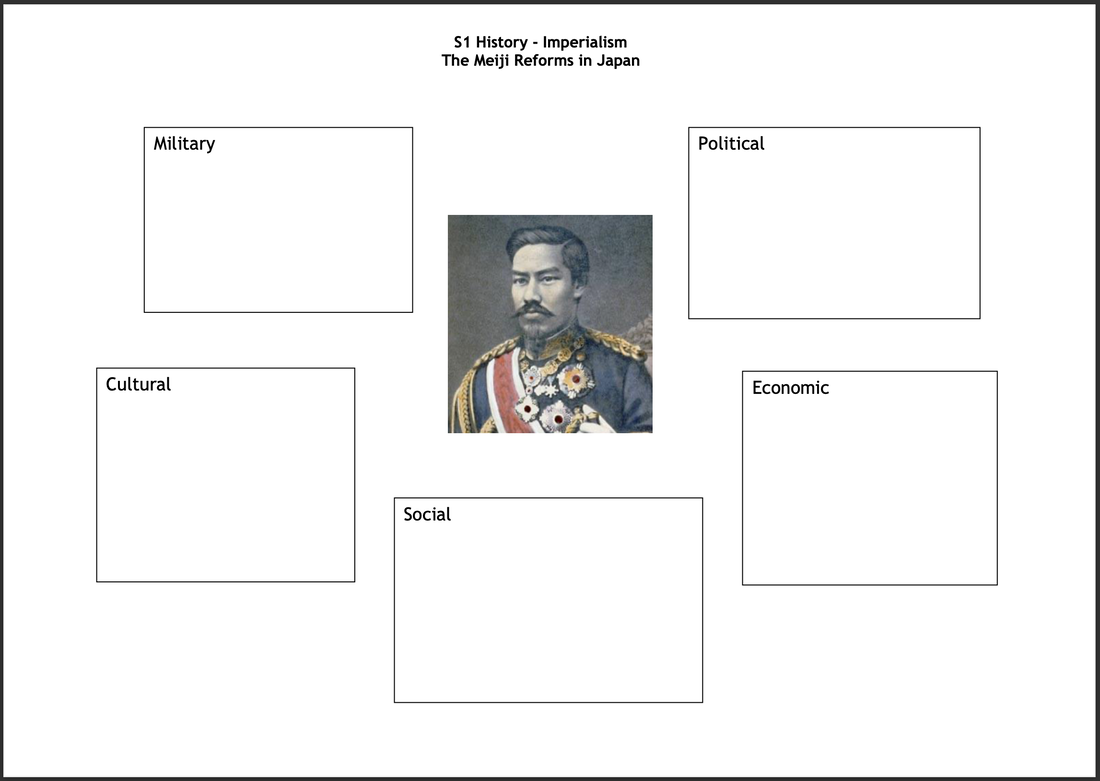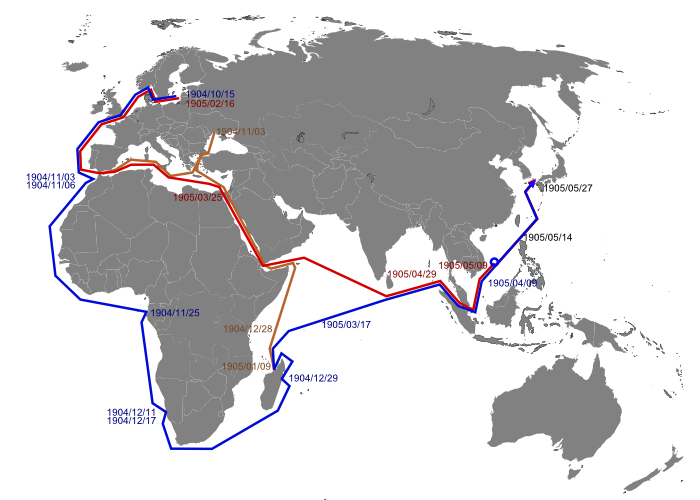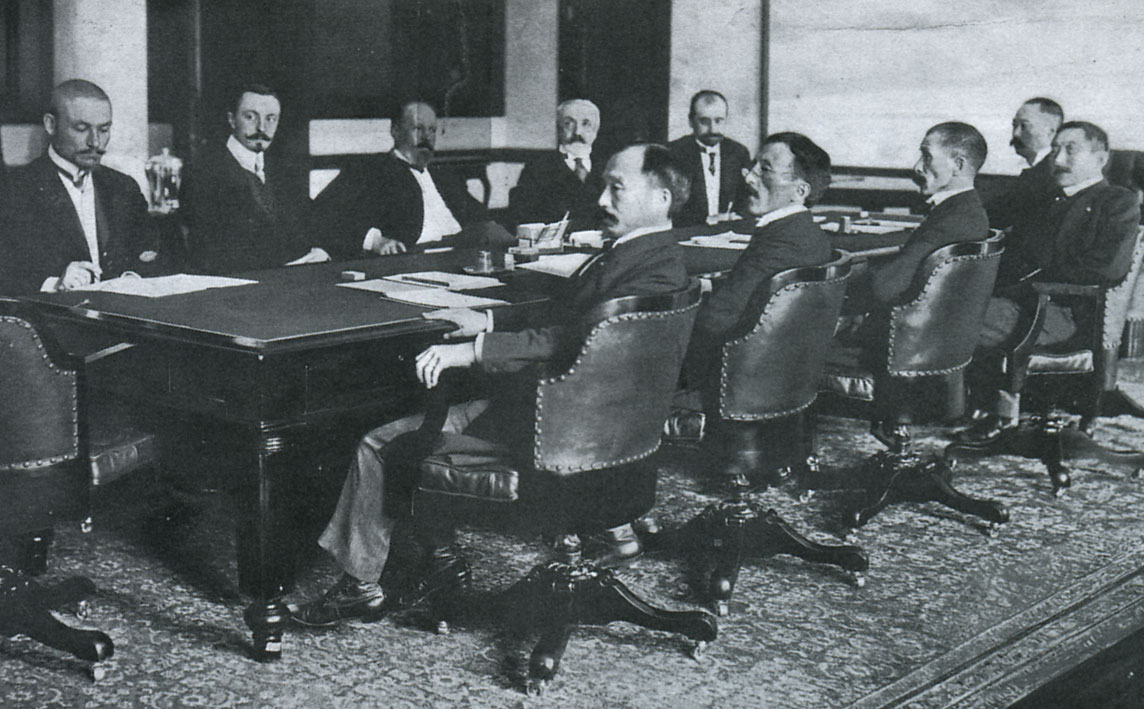Lesson 5 - Imperialism and Japan
This unit also features as an optional essay question in the IB DP syllabus as Paper 2 Topic 7: Origins, development and impact of industrialization (1750–2005) and, more importantly as important background for compulsory sourcework Paper 1 'Prescribed subject 3: The move to global war'. Case study 1: Japanese expansion in East Asia (1931–1941). Students who wish to be considered for the Moser Double Diploma will be encouraged to complete additional assignments in this unit.
At the beginning of this unit we examined a number of factors that gave rise to the phenomenon of New Imperialism. We examined social and economic, political and technological reasons why some non-European countries became subjugated to imperial overlords. One of the factors that was perhaps more difficult to understand is peripheral factors, the idea that one must view late nineteenth-century imperialism not only in terms of the motives of the ‘core’ expansionist powers but also in what happened locally, in the ‘periphery’.
As we saw last last lesson, China became a victim of imperial expansionism because of its weakness, because the Chinese ruling class failed in its mission of 'self-strengthening'. The case of Japan provides us with an interesting contrast to China and demonstrates the importance of 'peripheral' factors. As in China during the Opium Wars, Japan in 1854 was forced to submit to superior western technology and to open up their economy to western capitalism. But unlike in China, the modernisation programme of Japan that resulted from this imperial shock, was so successful that Japan became an imperial power in her own right capable of standing up to and defeating the Western powers.
At the beginning of this unit we examined a number of factors that gave rise to the phenomenon of New Imperialism. We examined social and economic, political and technological reasons why some non-European countries became subjugated to imperial overlords. One of the factors that was perhaps more difficult to understand is peripheral factors, the idea that one must view late nineteenth-century imperialism not only in terms of the motives of the ‘core’ expansionist powers but also in what happened locally, in the ‘periphery’.
As we saw last last lesson, China became a victim of imperial expansionism because of its weakness, because the Chinese ruling class failed in its mission of 'self-strengthening'. The case of Japan provides us with an interesting contrast to China and demonstrates the importance of 'peripheral' factors. As in China during the Opium Wars, Japan in 1854 was forced to submit to superior western technology and to open up their economy to western capitalism. But unlike in China, the modernisation programme of Japan that resulted from this imperial shock, was so successful that Japan became an imperial power in her own right capable of standing up to and defeating the Western powers.
|
Activity 1
Watch the Crash Course episode on Nationalism. It provides excellent revision of the concept of nationalism and the events of the early 19th century that you have already studied. It then moves on to the focus of today's lesson, Japan in late 19th century. |
|
What was Japan like before the arrival of Western imperialism?
|
In theory, Japan was ruled by an emperor, but in practice power lay in the hands of the Shogun, the most senior soldier in Japan; this was also a hereditary position. From 1603, the Shogun belonged to the rich and powerful Tokugawa family. Japan was divided into provinces and each of these was ruled by a feudal lord or daimyo, who owed his position to the Shogun. Below the daimyo in the feudal 'pyramid of power' came the samurai or warrior class. They had certain privileges, for example the right to wear swords, and they had to live by a certain code of behaviour called bushido (the way of the warrior) which stressed loyalty, bravery and honour. A samurai who behaved dishonourably was expected to commit suicide publicly by the ritual of seppuku (sword to the stomach). The majority of the population were rice growing peasants. They were kept in poverty by the high feudal taxes and in the 19th century there were many peasant uprisings.
|
The artisans and merchants were at the bottom of the pyramid of power, but as in France before the revolution their growing wealth meant that they were often more influential than those higher in the social order. They were growing in numbers and power and they wanted this power reflected by the position they held politically in the country.
Why were the Americans interested in Japan?
The Shogun kept Japan isolated from the West partly to make sure that no daimyo ever made alliances with other countries or got weapons from other countries but by the early nineteenth century, the Japanese policy of isolation was increasingly under threat. Between 1790 and 1853 at least twenty-seven U.S. ships (including three warships) visited Japan, only to be turned away. As the Americans expanded their territories westwards, and Oregon and California became part of the USA in 1848, the Pacific Ocean became a proximate sphere of interest. The Opium Wars had opened up China to trade and the British and French had established useful bases, especially for coal refuelling. Strategically it would be valuable if American ships trading between China and San Francisco could take on fresh provisions in Japan before crossing the vast expanse of the Pacific Ocean, as Yokohama was nearly 2000 km closer to San Francisco than Shanghai. In addition, Americans shared the European attitude to non-western nations that these were inferior people in need of civilisation and Christian teaching.
|
In 1853, the Americans therefore sent an armed naval mission to negotiate with the Japanese. The mission was led by Commodore Matthew Perry (See Japanese print right). The Americans impressed the Shogun with their show of force - steam-powered, ironclad warships with heavy guns. In 1854, Perry returned to Edo Bay with twice as many ships as before. The Japanese believed that he would attack if the American demands were not granted, so they agreed to negotiate. As a result, the Treaty of Kanagawa was signed in 1854 which forced forced Japan to:
■ open up the isolated ports of Hakodate and Shimoda to ships from the USA ■ allow the Americans to station a consul in Shimoda ■ treat shipwrecked sailors well ■ give the USA 'most favoured nation' status. |
This treaty was quickly followed by other treaties - with Britain in October 1854, with Russia in February 1855 and with the Netherlands in 1855.
By 1858, the Japanese had been persuaded via the Treaty of Edo with America, and similar treaties with other countries, to open up fully to commercial trade. However, these treaties were unequal. First, they allowed 'extraterritoriality', which meant that foreigners could be tried according to the laws of their own countries if they committed a crime (see the previous lesson on China and the Opium Wars). Second, the Japanese could not control their own tariffs levied on goods coming into Japan; and finally the USA got the benefit of any extra terms negotiated with other countries as it had 'most favoured nation' status.
By 1858, the Japanese had been persuaded via the Treaty of Edo with America, and similar treaties with other countries, to open up fully to commercial trade. However, these treaties were unequal. First, they allowed 'extraterritoriality', which meant that foreigners could be tried according to the laws of their own countries if they committed a crime (see the previous lesson on China and the Opium Wars). Second, the Japanese could not control their own tariffs levied on goods coming into Japan; and finally the USA got the benefit of any extra terms negotiated with other countries as it had 'most favoured nation' status.
Activity 2
Write a summary of the main causes and consequences of the American 'Perry Mission' to Japan.
Write a summary of the main causes and consequences of the American 'Perry Mission' to Japan.
The Japanese Response: The Meiji Restoration and reforms.
|
As in China, the humiliation of the unequal treaties led to calls for significant change. There was a difference though. In Japan, those calling for change and modernisation came out on top. After 14 years of struggle, the power of the Shogun was weakened and an 'enlightened' emperor, Meiji was restored to power. He also announced that Japan would take its place among the nations of the world, with the slogan Fukoku Kyohei: 'Enrich the country, strengthen the military'. In April 1868, the young Emperor signed the Charter Oath. The Charter Oath was important because it declared that from now on promotion to the highest positions in society was open to all - not just those in the privileged classes. It also told the Japanese people to learn from the rest of the world. As a result a number of important reforms were introduced
|
|
|
Political reform
Even though the Meiji Emperor had announced the Charter Oath, Japan was not a democracy. Japan set to achieve its goal of a constitutional monarchy through a number of stages. In 1889 a new Constitution was announced. They created a two chamber parliament and most people could vote. Japan continued to be governed by a small elite group of leaders called the genro. |
Social reform
Japan's new rulers understood that to modernize they would have to get rid of Japan's medieval feudal system. They needed to break up the power of the daimyo and samurai and strengthen the power of the central government. First, they abolished the domains and privileges of the daimyo. Second, the government abolished the privileges of the samurai. |
|
Economic reform
Many new factories opened due to investment from the government - the new Ministry of Industry developed and ran coal mines, cement works, shipbuilding yards and textile mills. The silk industry was particularly successful. The first telegraph line was built in 1869, railway in 1870 and, in 1871, a government postal system was established. Gas lighting was introduced into Japanese cities in 1872, and electricity became available in Tokyo by 1887. |
Cultural reform
Many wealthy Japanese began to wear Western clothes. Men wore moustaches, top hats, bow ties and Western-style suits. The Japanese began to use a Western calendar in 1872, and adopted a metric system 50 years before it was introduced into Britain! Education became compulsory in 1872, and Western knowledge was taught as well as traditional Japanese beliefs and skills. Children were brought up with a strong sense of patriotism and reverence for the Emperor. |
|
Military reform
The navy was modelled on that of the British, which was the strongest navy in the world at that time. The army was initially modelled on the French, but later adopted methods from the Germans. The Choshu and Satsuma armies were combined to form the new Imperial Army in 1872. Conscription was introduced in 1873. The new Imperial Army went on to defeat the European power of Russia in the Russo-Japanese war of 1904-5. (See below) |
Above, Tokyo in 1900
|
|
Activity 3
Complete this revision diagram in Word that summarises the main reforming features of the Meiji Restoration. Alternatively, download and annotate the image opposite. You are only allowed one sentence per box and you must use your own words. |
Consequences of the Meiji reforms
The central slogan of the Emperor Meiji had been Fukoku Kyohei: 'Enrich the country, strengthen the military'. As we saw last lesson, the First Sino-Japanese War between Japan and China in 1894–95 marked the emergence of Japan as a major world power and demonstrated the weakness of the Chinese empire. Although most foreign observers had predicted an easy victory for the larger Chinese forces, the Japanese modernisation meant they were better equipped and prepared. Japanese troops scored quick and overwhelming victories on both land and sea. By March 1895 the Japanese had successfully invaded Shandong province and Manchuria. In the Treaty of Shimonoseki, which ended the conflict, China recognized the independence of Korea and ceded Taiwan, the adjoining Pescadores, and the Liaodong Peninsula in Manchuria.
The central slogan of the Emperor Meiji had been Fukoku Kyohei: 'Enrich the country, strengthen the military'. As we saw last lesson, the First Sino-Japanese War between Japan and China in 1894–95 marked the emergence of Japan as a major world power and demonstrated the weakness of the Chinese empire. Although most foreign observers had predicted an easy victory for the larger Chinese forces, the Japanese modernisation meant they were better equipped and prepared. Japanese troops scored quick and overwhelming victories on both land and sea. By March 1895 the Japanese had successfully invaded Shandong province and Manchuria. In the Treaty of Shimonoseki, which ended the conflict, China recognized the independence of Korea and ceded Taiwan, the adjoining Pescadores, and the Liaodong Peninsula in Manchuria.
|
But the real test of the success of Emperor Meiji's modernisation project was to be proven in a war with one of Europe's Great Powers. The Russo-Japanese War was fought during 1904 and 1905 between the Russian Empire and the Empire of Japan over rival imperial ambitions in Manchuria and Korea. Russia wanted a warm-water port on the Pacific Ocean for its navy and for maritime trade. Vladivostok was operational only during the summer, whereas Port Arthur, a naval base in Liaodong Province leased to Russia by the Qing dynasty of China, was operational all year. Since the end of the First Sino-Japanese War in 1895, Japan feared Russian interference on its plans to create a sphere of influence in Korea and Manchuria.
After war broke out in 1904 Russia suffered multiple initial defeats by Japan, but Tsar Nicholas II, like most observers, was convinced that Russia would win and chose to remain engaged in the war, deploying the powerful Baltic fleet half way around the world. (See image right) |
|
The Japanese engaged the Russians in the Tsushima Straits on 27–28 May 1905. The Russian fleet was virtually annihilated, losing eight battleships, numerous smaller vessels, and more than 5,000 men, while the Japanese lost three torpedo boats and 116 men. Only three Russian vessels escaped to Vladivostok. War concluded with the Treaty of Portsmouth (right), mediated by US President Theodore Roosevelt. The consequences transformed the balance of power in East Asia and helped bring about a revolution in Russia which we will study later this year.
Another key reason why the reformers had embarked on a radical programme of modernisation was to enable Japan to revise the unequal treaties and take back control of their own country. |
Two key elements which emphasised foreign superiority had to be undone - first the extraterritorial rights and, second, foreign control of customs duties. Japan reformed its legal code in 1889 and so there was little reason for foreign nationals to want to live under another justice system. Britain, and then the other Western powers, gave up its extraterritorial rights in 1894. Foreign control over tariffs was also removed in 1911.
Activity 4
Outline how Japan established itself as a major global and imperial power in the late 19th and early 20th century.
Outline how Japan established itself as a major global and imperial power in the late 19th and early 20th century.
Optional (but recommended) activity.
Watch and make some summary notes from this episode of Crash Course History. It provides a good overview of what you have studied in this Unit on imperialism.
Watch and make some summary notes from this episode of Crash Course History. It provides a good overview of what you have studied in this Unit on imperialism.
|
|
Double Diploma students
|
The IB DP syllabus Topic 7: Origins, development and impact of industrialization (1750–2005) is a potential essay question you could do on Paper 2.
1. Watch the film opposite which provides a rather more detailed appreciation of the Meiji Restoration/Revolution. 2. Read through and complete the relevant activities on the Khan Academy website - The Global Transformations of the Industrial Revolution. |
|

